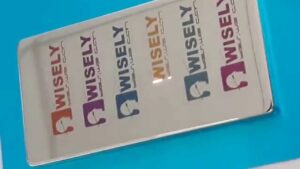Different Types of Color Laser Marking Machine
If you are in the market for a Color Laser Marking Machine, you have a variety of options. There are fiber laser engravers that etch black, white, grey, and even colors. You can also use a fiber laser engraver to engrave metals such as titanium, chromium, and stainless steel.
MOPA fiber laser marking machine
A MOPA fiber laser marking machine uses a single fiber laser source to engrave white, black, or gray. It can also engrave different colors on various metals, including stainless steel, titanium, and chromium. This machine is also great for engraving logos and text on products.
MOPA fiber lasers have a wide frequency range and adjustable pulse width. Compared to Q-switched fiber lasers, which have a fixed pulse width, the MOPA fiber laser has a much wider range. The frequency range is 1.5KHz to 1000KHz, and the pulse width is variable from four to two hundred nanoseconds.
A MOPA laser can also produce better results on some plastics than a conventional fiber laser. The laser can produce higher contrast on black polyamide, polypropylene, and PBT materials. Another advantage of MOPA lasers is that they have adjustable pulse durations, which makes them ideal for high-quality laser ablation and paint removal. Additionally, MOPA lasers are ideal for day/night markings in the automotive industry.
A MOPA fiber laser marking machine is more flexible than Q-switched fiber lasers because it has adjustable pulse width. In addition, MOPA fiber lasers can be used to mark a wider range of materials.
CO2 laser marking machines
The CO2 laser marking machine market is expected to grow considerably, owing to its improved performance over traditional marking techniques. However, the availability of alternative technologies is expected to hamper the growth of this market. Major companies are currently launching various research & development initiatives to improve CO2 laser marking machines and enhance their performance.
The CO2 laser marking machine works by emitting laser light, which is converted into heat by the laser. The laser beam can mark a wide range of materials, such as paper, cardboard, plastic, glass, wood, and coated metal. The CO2 laser is also capable of permanently marking leather, ceramics, and other materials.
CO2 laser marking machines use a CO2 glass laser tube as light source. The laser beam is reflected by a 2D fast-speed scanning lens and forms an image. These marking machines are the most advanced technology currently available. They can mark data in both two-dimensional and three-dimensional shapes, and can be integrated into a production line.
CO2 laser marking machines are ideal for high-speed precision marking, and can also mark non-metallic materials. They are widely used in electronics, semiconductors, electrical appliances, textiles, and mobile communications. These laser marking machine manufacturer are easy to use and do not require complex maintenance.
Green laser marking machines
Green laser marking machines produce highly visible, permanent marks. They have a power range of 5-10 watts and a wavelength of 532 nm. They are ideal for marking sensitive materials such as ceramics, PCBs, and semi-conductors. They have excellent precision and can mark objects as small as 10 microns. These marking machines can integrate seamlessly with existing assembly lines.
Green laser marking machines are becoming a popular choice for high-speed marking of electrical components. They can be used in a wide range of applications, from brand identity to traceability. They are also available for marking plastic and stainless steel. Some manufacturers offer free samples for testing purposes, allowing you to see the final product before purchasing.

A green laser emits much less energy than UV or CO2 lasers, which make them ideal for marking a wide range of soft materials. Additionally, they operate at half of the wavelength of fiber lasers. Most UV lasers emit a wavelength of 355 nm, which is less powerful than green lasers. Therefore, green lasers can mark a wide range of soft materials with exceptional precision.
The global laser marking machine market has experienced steady growth over the past several years. IMARC Group estimates that the market will grow at a moderate pace between 2011 and 2022. By 2026, it is forecasted to reach $3.43 billion, up from $2.45 billion in 2017.
eCobalt laser engraver
The eCobalt laser engravers feature variable laser power settings, an enclosed cabinet and are safe to use in a busy shop floor. They come with a 163 FL or optional 254 FL lens and a locked pulse duration of 200ns. The machine also features an optional fumes extraction system.
Color laser marking uses a high-powered laser to permanently mark the workpiece with a color. This technique does not vaporize the material; instead, the laser oxidizes the surface of the metal without vaporizing it. The process changes the microstructure of the metal, resulting in a permanent colored mark on the workpiece. While some metals are ideal for color laser marking, others cannot be marked.
The laser beam energy enables a wide variety of markings on the surface of metals. Its precise beam can deliver the highest resolution and power output efficiency. This machine is compatible with a variety of materials. It can engrave metals up to 8mm thick and is highly customizable.
Color laser engraving is a highly durable process that can survive everyday cleaning. Unlike traditional etching, this method is also resistant to abrasive conditions. A laser engraver is able to produce an image on metal, plastic, or wood with varying levels of brightness. The process also involves the removal of material from the workpiece, which reveals an image to the eye. The image is also tactile and can be felt with the hand.
Q-switched fiber laser marking machines
Q-Switched fiber laser marking machines are used for marking plastic, ceramic, and metal surfaces. They are highly versatile, offering high-speed and quality marking. This equipment allows for precise lining and smooth edges. They are suitable for marking both large and small products. Their unchanging pulse width and high frequency make them an ideal choice for marking various materials.
When deciding which type of laser marking machine to buy, consider the pulse length, frequency, and pulse width. Shorter pulses will be more concentrated and will reach higher peak powers. Some lasers use multiple resonator modes, which are limited in frequency and can cause mode beating effects.
A Q-switched fiber laser has an output pulse width that can be independently adjustable from two to 500 nanoseconds. These lasers are also available with a high repetition rate, ranging from a few milliseconds to several megahertz. The pulse width is generated by modulating the optical loss in the laser cavity.
Another important difference between the two types of lasers is the type of material they can mark. A Q-switched fiber laser is most common in a range of industries, while a MOPA laser uses a different type of laser to mark products. A MOPA laser has a small pulse width, which makes it suitable for marking thin metal and aluminum plates.
Carbonizing
Carbonizing is a method of marking organic or synthetic polymers. The heat from the laser breaks the plastic bonds and releases hydrogen and oxygen, darkening the area marked. However, carbonising is not suitable for marking dark objects, as it produces low contrast. The alternative is foaming, which is more suitable for light materials.
Laser marking has several advantages. Lasers can easily mark dark or light-colored materials. They can also produce complex designs. Laser marking is also possible on materials that are not easily etched. This process can be used on many types of materials, including anodized aluminum, coated metals, foils, films, and laminates. Another process, foaming, involves melting the material to form gas bubbles. The gas bubbles reflect light diffusely and create the marking.
Carbonizing marking is popular in the automobile industry and is an excellent way to create day-and-night markings. It is also used in keyboard and control elements in the packaging industry. It releases carbon and breaks plastic bonds, producing a rich contrast marking that can’t be achieved with any other method. Carbonization is also suitable for light plastics and organic materials.
Carbonizing color laser marking machines can be expensive but can be highly versatile. They can mark large batches of products with a high degree of consistency. They are more powerful than manual marking machines, and they can be used to mark large areas at a lower cost.

